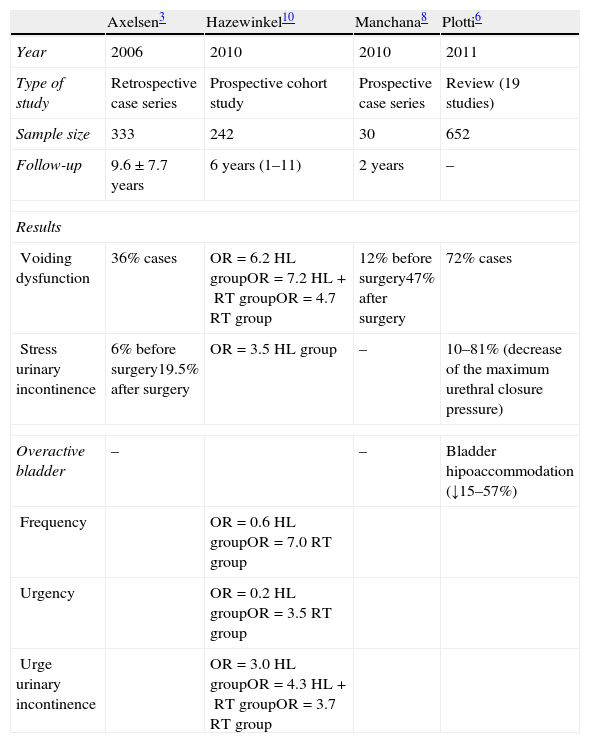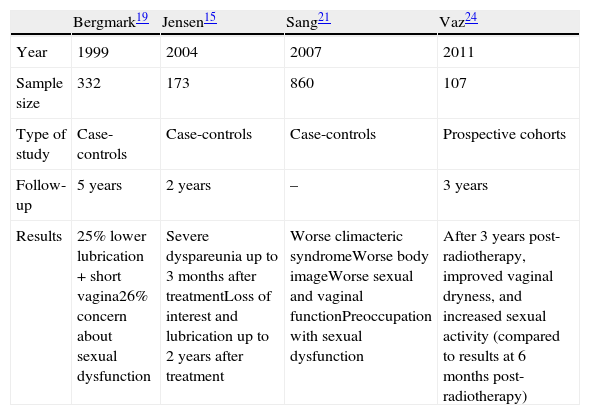Cervical cancer is the second most common tumor in women worldwide and due to diagnostic and therapeutic advances, the overall survival rates at 5 years is approaching 70%. Disorders in micturition, defecation, sexuality and quality of life have been described, frequently caused by different treatments. Addressing these comorbidities in the medical follow-up is often limited or nonexistent.
MethodsA systematic review of studies to identify the articles related with urogynecological sequels from cervical cancer treatment was carried out.
Summary of evidenceDuring radical hysterectomy, disruption of the autonomic nerve fibers which innervate the bladder appears to be the main cause of voiding dysfunction. Up to 36% of women report voiding dysfunction; from 10 to 80%, stress urinary incontinence (SUI), due to the decrease in urethral closure pressure. After radical hysterectomy and/or radiotherapy, vaginal shortening and stenosis is often observed. Sexual function is altered in these women and those who are sexually active women after the surgery frequently report sexual dysfunction due to lack of lubrication and pain.
ConclusionsVoiding dysfunction and urinary incontinence are the most frequent urinary problems that occur in patients treated for cervical cancer. Systemic urogynecologic assessment of the symptoms suggestive of micturition dysfunctions during oncologic follow-up may be useful to detect the cases that can be evaluated and treated in an Urogynecology Unit.
El cáncer de cérvix es el segundo tumor más frecuente en mujeres, y debido a los avances diagnósticos y terapéuticos las cifras de supervivencia global a 5 años se aproximan al 70%. Se han descrito trastornos en la función miccional, defecatoria, sexual y en la calidad de vida, debidas en gran parte a las secuelas originadas por los distintos tratamientos. El abordaje de estas comorbilidades en las consultas médicas de seguimiento es escaso o inexistente.
MétodosSe realizó una revisión sistemática para identificar los artículos relacionados con las secuelas uroginecológicas del tratamiento del cáncer de cérvix.
Resumen de evidenciaDurante la histerectomía radical, la disrupción de las fibras nerviosas del sistema nervioso autónomo que inervan la vejiga es probablemente la causa principal de las alteraciones miccionales. Hasta un 36% de las mujeres sufren disfunción de vaciado, y entre el 10 y 80% incontinencia urinaria de esfuerzo, debida a la disminución de la resistencia uretral. Tras la histerectomía radical y/o radioterapia se observa con frecuencia un acortamiento y estenosis de la vagina. La función sexual está alterada en estas mujeres, y aquellas que son sexualmente activas tras la cirugía con frecuencia refieren dispareunia y falta de lubricación vaginal.
ConclusionesLa disfunción de vaciado y la incontinencia urinaria son las disfunciones miccionales más frecuentes tras el tratamiento del cáncer cervical. Durante el seguimiento oncológico de estas pacientes, la valoración sistemática de los síntomas sugestivos de disfunciones miccionales permite detectar los casos que pueden ser evaluados y tratados en una Unidad de Uroginecología.










